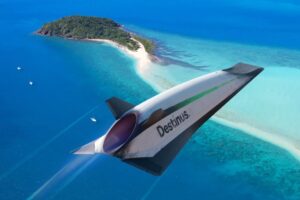The final space frontier has always captured the human imagination. From the first steps on the Moon to the ongoing exploration of Mars and beyond, space beckons mankind with its mysteries and possibilities. Explore with BOLD Awards the latest spacetech trends and discover what’s next on the horizon in space exploration and technology. Dive into the fascinating world of space innovation, missions, and the future of humanity’s journey beyond our planet.
1. Government Space Bodies Working With Commercial Operators
Space exploration and exploitation are no longer restricted to government agencies. Commercialization in the space frontier has become a reality, with companies like SpaceX, Blue Origin, and Virgin Galactic leading the way.
Elon Musk established the U.S. aerospace company SpaceX (Space Exploration Technologies Corporation) with an aim to develop space launch vehicles and reduce space transportation costs. He invested funds, built a team, and collaborated with numerous astrophysicists and other experts in developing the company with a well-publicized aim to send an astronaut to Mars. Along the way to this, he has led SpaceX to vital high profile contracts with NASA (the U.S. National Aeronautics and Space Administration) and the U.S. Air force to create and design launch rockets. His Mars mission is now a collaborative effort with NASA.
Commercial operators are also collaborating with space research bodies for scientists to conduct experiments in space. In October 2023, Richard Branson’s space tourism company announced that Virgin Galactic has teamed up with NASA for edge-of-space experimentation. In a sub-orbital space flight, a crew of researchers will conduct experiments approximately 50 miles (80.5 kilometers) above the Earth’s surface. Planetary scientist Alan Stern, the principal investigator of NASA’s New Horizons mission to Pluto, will wear a biomedical harness to assess researchers’ reactions to high G-forces and the microgravity environment. He will also test a wide-field visible and ultraviolet camera.
Blue Origin, founded by Jeff Bezos, has unveiled a full-sized mockup of an uncrewed version of its Blue Moon lunar lander that will test technologies intended for a crewed version it is developing for NASA’s Artemis effort. Blue Origin is one of 14 companies that are part of NASA’s Commercial Lunar Payload Services program for uncrewed lunar landings.
A guaranteed spacetech trend is that the commercial space industry is set to expand, offering more affordable and accessible opportunities for space travel, experimentation and payload delivery.
2. Spacetech Trends Benefitting Earth From Space
Let’s look at further exploitation of space by tech startups, one of the spacetech trends that delivers benefits back directly to people on Earth.
Working with the UK Space Agency, Skyrora is a startup that represents the next generation of private launch vehicle manufacturers aiming to meet the demand for launch vehicles in the fast growing small satellite market. A small satellite is one that weighs less than 500 kg. Operating in low Earth orbit, they are primarily used for remote sensing and communications.
Headquartered in Scotland, with facilities across Europe, Skyrora is developing small satellite launch vehicle technology with a range of single-stage, two-stage and three-stage launchers. Also, their Space Tug is based on the upper stage of a launch vehicle with adaptations that provide services to satellites already in orbit.
Open Cosmos was founded in the UK in 2015 with the vision of simplifying access to space using small satellites. It is dedicated to solving customer problems with insights from space through providing a complete end-to-end mission management service that designs, builds, launches and operates advanced satellites.They could be used for monitoring agricultural yields, assessing the damage of oil spills or providing navigation solutions. Open Cosmos believes that data from satellites is the most effective and sustainable way of achieving such outcomes.
Interstellar Lab has sites in France and US, and develops environment-controlled pods that create ideal conditions for plants to grow on Earth and in space. It has contracts with NASA and ESA to grow plants in Low Earth Orbit, Deep Space and Lunar surface. Their solutions for astronaut life support and food production in space are also adapted for use in sustainable farming and biodiversity conservation on Earth.
 Destinus is a European aerospace technology company designing and building a fleet of near-space hydrogen-powered hypersonic vehicles and the associated infrastructures to support the world’s fastest transportation network. Hypersonic aircraft travel at more than five times the speed of sound and reduce travel times to the other side of the world to just three to four hours. Destinus operates from locations in Switzerland, Germany, Spain, and France.
Destinus is a European aerospace technology company designing and building a fleet of near-space hydrogen-powered hypersonic vehicles and the associated infrastructures to support the world’s fastest transportation network. Hypersonic aircraft travel at more than five times the speed of sound and reduce travel times to the other side of the world to just three to four hours. Destinus operates from locations in Switzerland, Germany, Spain, and France.
What comes next in this sector is in the hands of companies like these. All four of these examples have been winners in the Boldest Space Frontier category of the annual global BOLD Awards for digital industries
3. Space Mining and Resource Utilization

The idea of mining asteroids for valuable resources is no longer a spacetech trend that sounds like science fiction, but it’s rapidly becoming a feasible concept in the space frontier. Companies are exploring the potential of asteroid mining to extract precious metals and water, which could sustain future deep space missions. NASA’s OSIRIS-Rex spacecraft successfully gathered samples from an asteroid. It returned to Earth on September 24, 2023, to drop off material from asteroid Bennu.
As technology advances, we can expect more ambitious plans for space mining and resource utilization. This could be a game-changer for space exploration and sustainability. It is certainly enough of an incentive for further development of autonomous mobile robots to operate on the Moon and then further out in space.
4. Mars Colonization
Mars has been a focal point of human exploration for decades. Recent missions, such as NASA’s Perseverance rover and SpaceX’s Starship, are paving the way for potential human colonization. The goal is to establish a sustainable presence on the Red Planet.
It will require significant new technology. As an example, the Mars Oxygen In-Situ Resource Utilization Experiment, or MOXIE, is helping NASA prepare for human exploration of Mars. MOXIE will test a way for future explorers to produce oxygen from the atmosphere on Mars for burning fuel and breathing.
The next spacetech trends include sending crewed missions to Mars, building habitats, and developing further technologies to support life on another planet. Mars colonization could become a reality within a lifetime. 3D printing is being explored as a means to build accommodation on Mars. Perhaps breakthroughs achieved in the space frontier could be utilized on Earth, like providing accommodation in other harsh or ‘alien environments’ such as under the sea?
5. Advancements in Space Telescopes

Space telescopes like the Hubble have given us breathtaking images of distant galaxies and deep space. The launch of the James Webb Space Telescope (JWST) enabled astronomers and scientists to see even further into the cosmos and gain insights into the origins of the universe. Given the time it takes for light to travel vast distances, the JWST is also like a time machine: it shows us what took place billions of years ago. A 3D visualization concludes at Maisie’s Galaxy, which at 13.4 billion light-years from Earth is one of the most distant galaxies ever observed by humanity.
An early citizen scientist/crowdsourcing project conducted using images from JWST involved students trained to classify more than 5,000 high-redshift galaxy candidates by evaluating their shape and brightness in multiple imaging filters. The Zooniverse Project Builder was used to present the data to the students for inspection and to collect their classifications. The work helped the project team improve the AI criteria for selecting high-redshift galaxy candidates, and to determine which of thousands of candidates they should prioritize for the JWST spectroscopic observations.
The JWST will continue to open new frontiers in astronomy, studying exoplanets and distant celestial objects in unprecedented detail. This could lead to groundbreaking discoveries about the nature of the universe.
6. Space Tourism and Beyond
Space tourists are now able to experience weightlessness and witness Earth from space, though space tourism is just at its beginning. Orbital Assembly, a company that specializes in designing and constructing space stations, is planning to open luxury accommodation in space. In its infancy, accommodation in space is likely to blur between being used for tourism, research purposes, and commercial objectives. Corporate employees could be accommodated together with ultra-high-net-worth individuals.
Future spacetech trends hold the promise of space habitats, orbital factories, and the potential for humans to live and work in space for extended periods. This could mark a significant shift in how we view space as a place for both exploration and commerce.
Expect to see an increase in space tourism options, including trips to the International Space Station and private space stations. Space-based industries may become a significant part of the global economy. We may soon see the first hotels in space and the beginnings of space colonization efforts.
7. International Collaboration
Space exploration has historically been a collaborative effort among nations. The International Space Station (ISS) is a testament to what can be achieved through international cooperation. The project involves five space agencies that when it began represented 15 countries: the United States’ NASA, Russia’s Roscosmos, Japan’s JAXA, Europe’s ESA, and Canada’s CSA.
The European Space Agency is now an international alliance with 22 member states. In the past few years other international space blocs have emerged. These include the African Space Agency, with 55 member states; the Latin American and Caribbean Space Agency, with seven member states; and the Arab Space Coordination Group, with 12 member states in the Middle East.
Spacetech trends include collaboration between government agencies and commercial organizations, as we have already covered earlier.
As we look to the future, collaboration will continue to be vital in addressing the challenges of space exploration. The most important reason for collaboration is the sharing of resources and expertise – and cost. Resources can include raw materials, and infrastructure such as launch sites. Sharing expertise on space projects helps minimise the duplication of experiments, and allows for the involvement of experts from countries that do not have their own space programs.
Future missions to the Moon, Mars, and beyond will likely involve multiple nations working together in the space frontier to pool resources, knowledge, and expertise.
Conclusion
As we venture beyond the stars, the spacetech possibilities are boundless. From commercial space travel to Mars colonization and the exploration of distant galaxies, the space frontier is expanding in ways beyond what was thought impossible. The future of space exploration promises to be a thrilling journey, filled with scientific discoveries, technological advancements, and the potential for humanity to establish a permanent presence beyond our home planet. As we consider the latest spacetech trends, we are reminded that the human spirit of exploration knows no bounds. Spacetech provides a stimulating and rewarding environment for tech entrepreneurs.
Be at the BOLD Awards Gala Dinner Ceremony
 Entries have closed and the finalists have been shortlisted for the 2024 BOLD Awards. Applications are open for you to request an invitation to attend the award ceremony on March 22nd, 2024, in Venice, Italy. It is a truly unique networking opportunity to meet international award winners and finalists in 33 categories of digital industries and the technology that powers them. Further details and how to apply are at https://bold-awards.com/request-an-invitation-for-bold-v/ #beBOLD
Entries have closed and the finalists have been shortlisted for the 2024 BOLD Awards. Applications are open for you to request an invitation to attend the award ceremony on March 22nd, 2024, in Venice, Italy. It is a truly unique networking opportunity to meet international award winners and finalists in 33 categories of digital industries and the technology that powers them. Further details and how to apply are at https://bold-awards.com/request-an-invitation-for-bold-v/ #beBOLD






